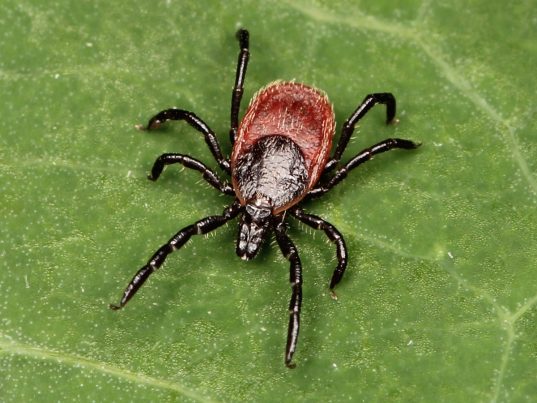
Rickettsial infection – causes, side effects and treatments at NaturalPedia.com
Thursday, August 02, 2018 by Ralph Flores
http://www.naturalpedia.com/rickettsial-infection-causes-side-effects-and-treatments-at-naturalpedia-com.html

Rickettsial infections (or rickettsiosis) refer to bacterial infections caused by the Rickettsia, Orientia, Ehrlichia, Neorickettsia, Neoehrlichia, and Anaplasma genera. There are two types of infections: the typhus group and the spotted fever group (SFG).
The infection is transmitted to humans by pathogens found in fleas, lice, mites, and ticks – especially during bites, where they inoculate infectious fluids into the skin. The incubation period for most diseases ranges from five to 14 days, with most travelers experiencing symptoms after their trip.
The following are some diseases caused by Rickettsiae genera.
- Anaplasma spp. – Human anaplasmosis
- Ehrlichia spp. – Human ehrlichiosis
- Neoehrlichia mikurensis – Neoehrlichiosis
- Neorickettsia sennetsu – Sennetsu fever, neorickettsiosis
- Orientia tsutsugamushi – Scrub typhus
- Rickettsia spp. – Spotted fever

Known risk factors and symptoms of rickettsial infections
The primary risk factor for rickettsial infections is traveling or living in a place endemic to a disease. In the U.S., almost all areas are known to have Rocky Mountain spotted fever (RMSF), but major incident areas include North Carolina, Oklahoma, South Carolina, Tennessee, and Arkansas.
For the most part, males are more likely to be affected by tick-borne rickettsioses, mainly due to greater recreational exposures to tick habitats. On the other hand, females are more resistant to certain spotted fever illnesses (like Q fever) because of the presence of protective female hormones.
Rickettsial infection affect all ages, with some exceptions: RMSF is seen mainly in children aged 15 and younger and Q fever is more prevalent between 30–70 years.
Common symptoms of rickettsial infections include:
- Fever
- Severe headaches
- A characteristic rash
- Malaise (generally feeling unwell)
- A sore covered by a black scab (eschar)
- Swollen lymph nodes at the onset
- Confusion
- Severe weakness
- Flu-like symptoms
- Vomiting
In severe infections, gangrene may develop, and liver, spleen, or kidney functions may fail. The person’s blood pressure could fall dangerously low, causing shock. In some cases, this can result in death.
Body systems affected by rickettsial infections
If the infection is identified and addressed early on, complications for rickettsiosis are rare. Still, complications to look out for include:
- Bronchopneumonia
- Congestive heart failure
- Multi-organ failure
- Deafness
- Inflammation of heart muscle and heart lining
- Inflammation of the kidneys
Food items or nutrients that may prevent rickettsial infections
There are no certain food items that will specifically prevent or relieve rickettsial infections, but some recommended food items to consume while battling an illness include:
- Chicken soup: It’s an excellent source of essential vitamins and minerals and also acts as a natural decongestant.
- Broths: Drinking broth is a great way to maintain hydration while sick.
- Garlic: The active ingredients in garlic fight bacterial infections and boost the immune system.
- Black tea: It can reduce bacterial growth, especially in the throat.
- Honey: It contains natural antibacterial properties and can help relieve coughing.
Treatments, management options for rickettsial infections
Most rickettsial infections are transmitted through tick bites; it is important to properly get rid of a tick bite once it is identified. Some options include:
- Citrus fruits
- Aromatherapy oils (e.g., cinnamon, basil, lemon, lavender, cedar, and pennyroyal)
- Rose geranium essential oil
- Apple cider vinegar
- Baking soda – make a paste by adding a little quantity of water then apply to the affected area
- Clove extract – mix with peppermint oil and water and spray
- Cinnamon oil
- Mint
- Coconut oil
Where to learn more
- Antioxidants may protect against tick-borne illness (press release)
- Revolutionary diagnosis: A single blood test can now detect Lyme and other tick-borne diseases
- New hardy tick infesting New Jersey expected to migrate westward, experts warn the public to be extra careful
- How to treat Lyme disease naturally, with diet, herbal supplements, vitamin C
Summary
Rickettsial infections are bacterial infections caused by the Rickettsia, Orientia, Ehrlichia, Neorickettsia, Neoehrlichia, and Anaplasma genera.
Rickettsial infections are classified between the typhus group and the spotted fever group (SFG).
Rickettsial infections are transmitted to humans by pathogens found in fleas, lice, mites, and ticks.
If rickettsial infections are identified and addressed early on, complications are rare.
Sources include:
Tagged Under: Tags: Rickettsial infections





